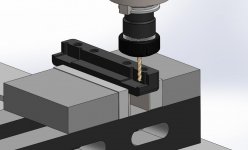Generic Default
Aluminum
- Joined
- Jan 23, 2016
- Location
- Wilmington / Long Beach
I have a whole set of parts that I'm going to get made in fairly small quantities (15-60 of each part). It won't be happening for a long time, so I don't want to send out RFQs yet since I'll probably I tweak the designs between now and then. I always machine my own prototypes before I send out RFQs.
But I still want to have a ball-park price range for the parts during the design process. I know how much the raw material for each part costs, nothing fancy, just 6061 flat bar and/or plate. Prices for the blocks of aluminum are $30 to $85 from online retail sources.
The parts are simple, blocky, and can easily be machined in any VMC in a 6 inch or 8 inch vise. I know the exact amount of material that needs to be removed from the stock for each part. Features are simple slots, profiles, pockets, counterbored bolt holes, a few tapped holes, and facing. Parts shown below; the blocks are 10 inches in the largest dimension.

My best guesstimate is to find the approximate cycle time per part, multiply it by an assumed shop rate of $100 per hour, and then add the cost of the raw material to it. Plus a little bit more for shipping, CAM time, anodizing, ect... spread over the total batch size.
For example, one of the blocks with the large center hole starts at 240 cubic inches and ends up just over 120 cubic inches. If the shop hogs out the part at a decent rate (15hp?) the total cycle time for the entire part, front and back, should be less than 10 minutes.
So 10 minutes = $17 shop time + $80 material + (setup hassle time) gives a final part cost of roughly $115 per part
The reason I'm posting this here is because I want to get your expert machinist/shop owner advice on pricing this stuff. Am I correct in my estimating logic? What am I not accounting for? I'm early on in a manufacturing career, and I plan on doing this type of stuff for the next few decades, so give me your best advice and guidance!
But I still want to have a ball-park price range for the parts during the design process. I know how much the raw material for each part costs, nothing fancy, just 6061 flat bar and/or plate. Prices for the blocks of aluminum are $30 to $85 from online retail sources.
The parts are simple, blocky, and can easily be machined in any VMC in a 6 inch or 8 inch vise. I know the exact amount of material that needs to be removed from the stock for each part. Features are simple slots, profiles, pockets, counterbored bolt holes, a few tapped holes, and facing. Parts shown below; the blocks are 10 inches in the largest dimension.

My best guesstimate is to find the approximate cycle time per part, multiply it by an assumed shop rate of $100 per hour, and then add the cost of the raw material to it. Plus a little bit more for shipping, CAM time, anodizing, ect... spread over the total batch size.
For example, one of the blocks with the large center hole starts at 240 cubic inches and ends up just over 120 cubic inches. If the shop hogs out the part at a decent rate (15hp?) the total cycle time for the entire part, front and back, should be less than 10 minutes.
So 10 minutes = $17 shop time + $80 material + (setup hassle time) gives a final part cost of roughly $115 per part
The reason I'm posting this here is because I want to get your expert machinist/shop owner advice on pricing this stuff. Am I correct in my estimating logic? What am I not accounting for? I'm early on in a manufacturing career, and I plan on doing this type of stuff for the next few decades, so give me your best advice and guidance!



 )
)


